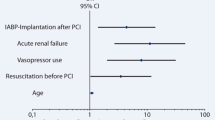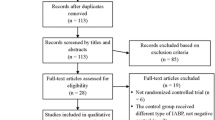Abstract
Aims
The recommendation for the use of the intra-aortic balloon pump (IABP) as adjunct in patients with cardiogenic shock undergoing primary PCI in current guidelines is controversial. We sought to investigate the use and impact of the outcome of IABP in current practice of percutaneous coronary interventions in Germany.
Methods and results
Between January 2006 and December 2011, a total of 55,008 consecutive patients with acute coronary syndromes undergoing PCI in 41 hospitals were enrolled into the prospective Arbeitsgemeinschaft Leitende Kardiologische Krankenhausärzte registry. Of these, 22,039 had STEMI and 32,969 had NSTEMI, and cardiogenic shock was observed in 1,435 (6.5 %) and 478 (1.4 %), respectively. Of the total of 1,913 patients with shock, 487 (25.5 %) were treated with IABP. In-hospital mortality with and without IABP was 43.5 and 37.4 %. In the multivariate analysis, the use of IABP was associated with a strong trend for an increased mortality (odds ratio 1.45, 95 % CI 1.15–1.84).
Conclusion
In the current clinical practice in Germany, IABP is used only in one quarter of patients with cardiogenic shock treated with primary PCI. We observed no benefit of IABP on outcome, which supports the findings of the randomized IABP-Shock II trial.



Similar content being viewed by others
References
Goldberg RJ, Samad NA, Yarzebski J, Gurwitz J, Bigelow C, Gore JM (1999) Temporal trends in cardiogenic shock complicating acute myocardial infarction. N Engl J Med 340:1162–1168
Hochman JS, Sleeper LA, Webb JG et al (1999) Early revascularization in acute myocardial infarction complicated by cardiogenic shock. SHOCK Investigators. Should we emergently revascularize occluded coronaries for cardiogenic shock. N Engl J Med 341:625–634
Zeymer U, Vogt A, Zahn R, Weber MA, Tebbe U, Gottwik M, Bonzel T, Senges J, Neuhaus KL (2004) Predictors of in-hospital mortality in 1333 patients with acute myocardial infarction complicated by cardiogenic shock treated with primary percutaneous coronary intervention (PCI). Eur Heart J 25:322–328
Moulopoulos S, Stamatelopoulos S, Petrou P (1986) Intraaortic balloon assistance in intractable cardiogenic shock. Eur Heart J 7:396–403
Van de Werf F, Bax J, Betriu A et al (2008) Management of acute myocardial infarction in patients presenting with persistent ST-segment elevation: the task force on the management of ST-segment elevation acute myocardial infarction of the European Society of Cardiology. Eur Heart J 23:2909–2945
Sjauw KD, Engstrom AE, Vis MM et al (2009) A systematic review and meta-analysis of intra aortic balloon pump therapy in ST-elevation myocardial infarction: should we change the guidelines? Eur Heart J 30:459–468
Werdan K, Russ M, Buerke M et al (2011) Deutsch-österreichische S3 Leitlinie: infarktbedingter kardiogener Schock—Diagnose, Monitoring und Therapie. Kardiologe 5:166–224
Neuhaus KL (1996) Qualitätssicherung bei Koronararteriendilatation. Dt Ärztebl 93:2642–26444
Zeymer U, Zahn R, Hochadel M et al (2005) Indikationen und Komplikationen bei Herzkatheterdiagnostik und percutaner coronarer Intervention im Jahr 2003. Ergebnisse des Qualitätssicherungs-Registers der Arbeitsgemeinschaft Leitende kardiologische Krankenhausärzte (ALKK). Z Kardiol 94:392–398
Jeger RV, Harkness SM, Ramanathan K et al (2006) Emergency revascularization in patients with cardiogenic shock on admission: a report from the SHOCK trial and registry. Eur Heart J 27:664–670
Hollenberg SM (2004) Recognition and treatment of cardiogenic shock. Semin Respir Crit Care Med 25:661–671
Babaev A, Frederick PD, Pasta DJ et al (2005) Trends in management and outcomes of patients with acute myocardial infarction complicated by cardiogenic shock. JAMA 294:448–454
Barron HV, Every NR, Parsons LS et al (2001) The use of intra-aortic balloon counterpulsation in patients with cardiogenic shock complicating acute myocardial infarction: data from the National Registry of Myocardial Infarction 2. Am Heart J 14:933–939
Stone GW, Ohman EM, Miller MF et al (2003) Contemporary utilization and outcomes of intra-aortic balloon counterpulsation in acute myocardial infarction: the benchmark registry. J Am Coll Cardiol 4:1940–1945
Prodzinsky R, Lemm H, Swyter M et al (2010) Intra-aortic balloon counterpulsation in patients withacute myocardial infarction complicated by cardiogenic shock—the prospective, randomised iabp shock trial for attenuation of multi-organ dysfunction syndrome. Crit Care Med 38:152–160
Stone GW, Marsalese D, Brodie BR et al (1997) A prospective, randomized evaluation of prophylactic intraaortic balloon counterpulsation in high risk patients with acute myocardial infarction treated with primary angioplasty. Second primary angioplasty in myocardial infarction (PAMI-II) trial investigators. J Am Coll Cardiol 29(7):1459–1467
Patel M, Smalling R, Thiele H et al (2011) Intra-aortic balloon counterpulsation and infarct size in patients with acute anterior myocardial infarction without shock. JAMA 306:1329–1337
Nanas JN, Moulopoulos SD (1994) Counterpulsation: historical background, technical improvements, hemodynamic and metabolic effects. Cardiology 84:156–167
Ohman EM, Hochman JS (2001) Aortic counterpulsation in acute myocardial infarction: physiologically important but does the patient benefit? Am Heart J 141:889–892
Zeymer U, Bauer T, Hamm CW et al (2011) Use and impact of intra-aortic balloon pump on mortality in patients with acute myocardial infarction complicated by cardiogenic shock: results of the Euro Heart Survey on PCI. EuroIntervention 7:437–441
Curtis JP, Rathore SS, Wang Y et al (2012) Use and effectiveness of intra-aortic balloon pumps among patients undergoing high risk percutaneous coronary intervention: insights from the National Cardiovascular Data Registry. Circ Cardiovasc Qual Outcomes 5:21–30
Thiele H, Zeymer U, Neumann F et al (2012) Intraaortic balloon support for myocardial infarctioncomplicated by cardiogenic shock. N Engl J Med 367(14):1287–1296
Author information
Authors and Affiliations
Corresponding author
Rights and permissions
About this article
Cite this article
Zeymer, U., Hochadel, M., Hauptmann, KE. et al. Intra-aortic balloon pump in patients with acute myocardial infarction complicated by cardiogenic shock: results of the ALKK-PCI registry. Clin Res Cardiol 102, 223–227 (2013). https://doi.org/10.1007/s00392-012-0523-4
Received:
Accepted:
Published:
Issue Date:
DOI: https://doi.org/10.1007/s00392-012-0523-4




